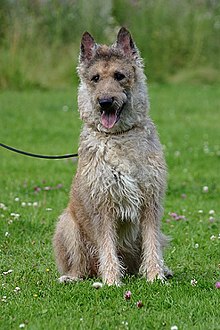Laekenois dog
 |
||||||||||||||||||||||||||||||||||
| Other names | Belgian Laekenois Belgian Shepherd Dog (Laeken) Chien de Berger Belge |
|||||||||||||||||||||||||||||||||
|---|---|---|---|---|---|---|---|---|---|---|---|---|---|---|---|---|---|---|---|---|---|---|---|---|---|---|---|---|---|---|---|---|---|---|
| Origin | Belgium | |||||||||||||||||||||||||||||||||
|
||||||||||||||||||||||||||||||||||
|
||||||||||||||||||||||||||||||||||
| Domestic dog (Canis lupus familiaris) | ||||||||||||||||||||||||||||||||||
| Traits | |||
|---|---|---|---|
| Weight | Male | 25–30 kg (55–66 lb) | |
| Female | 20–25 kg (44–55 lb) | ||
| Height | Male | 61–66 cm (24–26 in) | |
| Female | 56–61 cm (22–24 in) | ||
| Coat | rough. medium length | ||
| Colour | light fawn to red brown with black shading | ||
| Life span | 10-12 years | ||
| Classification / standards | |||
|---|---|---|---|
| FCI | Group 1, Section 1 Sheepdogs #015b | standard | |
| AKC | Miscellaneous | standard | |
| The AKC Foundation Stock Service (FSS) is an optional recording service for purebred dogs that are not yet eligible for AKC registration. | |||
| The AKC Miscellaneous class is for breeds working towards full AKC recognition. | |||
| ANKC | Group 5 (Working Dogs) | standard | |
| CKC | Group 7 - Herding Dogs | standard | |
| KC (UK) | Pastoral | standard | |
| NZKC | Working | standard | |
| UKC | Herding Dogs | standard | |
The Laekenois is a breed of dog, sometimes classified as a variety of the Belgian Shepherd rather than as a separate breed. "Laekenois" is pronounced /ˈlækᵻnwɑː/ LAK-in-wah. This breed is not fully recognized in the United States. However, they can be shown in Britain, Canada, Australia, and throughout Europe, along with all three of the closely related breeds which share a heritage with the Laekenois: the Tervuren, the Malinois, and the Groenendael, the last being shown in the U.S. as the Belgian Sheepdog.
Like all Belgian Shepherds, the Laekenois is a medium-sized, hard-working, square-proportioned dog in the sheepdog family with sharply triangular ears. The Laekenois is recognized by its woolly brown and white coat, intermixed so as to give a tweedy appearance. Most kennel clubs' standards allow for black shading, principally in muzzle and tail, indicating the presence of the melanistic mask gene.
The Belgian Laekenois originated as a dog for herding sheep at the Royal Castle of Laeken. Besides its role as a herding dog, this breed is also used to guard linen that is placed in fields to dry. In the First and Second World War, the Laekenois was used a messenger dog .
The Laekenois is considered both the oldest and the most rare of the Belgian Shepherd Dogs. Until the advent of dog shows in the early 1900s, the four varieties were freely intermixed, in fact, there are only three genes (short/long coat, smooth/wire coat, fawn/black coat) that separate the varieties genetically. Purebred Laekenois occasionally give birth to smooth-coated puppies, which, depending on the pure-bred registry, can be registered as Malinois.
...
Wikipedia
